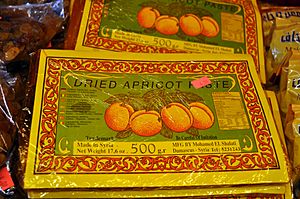Qamar al-Din facts for kids
 |
|||||||
| Alternative names | Lavāshak Qamaruddin | ||||||
|---|---|---|---|---|---|---|---|
| Type | Drink | ||||||
| Place of origin | Syria | ||||||
| Region or state | Ghouta | ||||||
| Associated national cuisine | Levantine | ||||||
| Serving temperature | Cold | ||||||
| Main ingredients | Apricots | ||||||
| Ingredients generally used | Orange blossom water, sugar | ||||||
| 38 kcal (159 kJ) | |||||||
|
|||||||
Qamar al-Din is a delicious apricot treat! It's a type of fruit leather made from apricots. People often turn it into a sweet and refreshing juice or nectar drink. This special drink comes from Arab cuisine and is very popular during the Muslim holy month of Ramadan.
Many believe Qamar al-Din first came from Syria. It was first made in a place called the Ghouta, where the best apricots for this treat grew. Qamar al-Din is enjoyed all over the Middle East and North Africa, and even in Somalia. Syrian Qamar al-Din is still thought to be the best because the perfect apricots for it grow mainly in Syria and southwestern Turkey. In Iran, it's known as lavāshak and is often eaten as a dried fruit roll.
Contents
What's in a Name? The Story of Qamar al-Din
There are a few interesting stories about how Qamar al-Din got its name.
One story says it was named after the person who invented it, a Syrian man named Qamar al-Din. He was said to be so handsome that people thought he looked like the moon! The Arabic word for moon is qamar.
Another idea is that when Qamar al-Din was first made, apricot season happened at the same time as the new moon appeared, marking the start of Ramadan. A similar story, popular in Egypt, says the name came from a Caliph (a Muslim leader) who would celebrate seeing the crescent moon during Ramadan by drinking Qamar al-Din.
How is Qamar al-Din Made?
Making Qamar al-Din starts with fresh apricots and sugar. These are boiled together over a fire. Then, the mixture is pressed through a special wooden strainer that has been soaked in olive oil.
After straining, the apricot paste is left out in direct sunlight to dry completely. Once it's fully dried, it becomes a thick, firm sheet of fruit leather. This dried apricot leather is then packaged and sold. It's thicker and has a stronger apricot flavor than regular apricot leather, which makes it perfect for turning into a drink.
Turning it into a Drink
To make the Qamar al-Din drink, you just need to add rosewater or orange blossom water to the dried apricot leather. Sometimes, people also add fresh or dried apricot pieces and ice. You can even use orange juice or plain water instead of some of the floral water.
Qamar al-Din is usually served thick and cold. It's known to be very good for you, giving you energy, electrolytes, and hydration. This is especially helpful after a day of fasting during Ramadan. In the Levant region, some people add pine nuts and ice to their Qamar al-Din. This makes it a bit like a thicker, apricot-flavored version of another drink called jallab. In Syria, people also enjoy eating the fruit roll by itself as a snack. A common way to eat it is by wrapping the fruit leather around a piece of walnut.
Lavāshak: Iran's Version
The Iranian version, called lavāshak, is made a bit differently. First, fruits are heated with some water until they become a smooth purée. This purée is then passed through a sieve to remove any fruit peels. The purée is heated again to make it thicker, then left in the sun to dry for a few days. Traditionally, lavāshak is made from plums or apricots. However, modern versions can also use fruits like apple, pomegranate, cherry, barberry, and Cornelian cherries.
See also
 In Spanish: Qamar al-Din para niños
In Spanish: Qamar al-Din para niños


